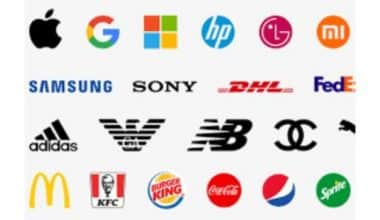Marketing can be expensive, especially if you’re trying to please everyone at once. When I initially started content writing, I quickly understood that speaking to a large audience with a one-size-fits-all message would not suffice. This led me to learn about the power of benefit segmentation—a method that not only allows businesses to speak directly to their customers’ needs but also significantly increases their marketing ROI. So, how does benefit segmentation lead to smarter campaigns and greater returns? Let’s dive right in and start exploring.
Key Takeaways
- Benefit segmentation enables businesses to create tailored messages that resonate with specific customer groups, increasing engagement and conversion rates. By focusing on what matters most to each segment, businesses can reduce wasted marketing spend and maximize returns.
- Benefit segmentation allows businesses to identify high-value customer segments and focus marketing efforts on them. For example, a skincare company increased its sales by targeting customers seeking anti-aging benefits, demonstrating the power of targeted campaigns.
- Speaking directly to customer desires through benefit segmentation enhances engagement, leading to higher conversion rates and improved customer retention. Customers who feel understood are more likely to stay loyal, reducing churn and improving long-term business outcomes.
- Tracking and analyzing customer behavior is crucial for refining benefit segmentation strategies. Tools like Matomo allow marketers to dive deeper into segmentation analytics, helping them tweak and optimize campaigns for even better performance over time.
What is Benefit Segmentation?

Before I get into how benefit segmentation can change your marketing strategy, let me define what it means. Benefit segmentation explains how benefit segmentation can change your marketing strategy, let me define it. Benefit segmentation involves categorizing your clients based on the benefits they expect from a product or service. These advantages range from convenience to affordability, quality, or even status. Instead of lumping all of your consumers together, divide them into discrete segments based on what inspires each group.
This means benefit segmentation classifies your target audience based on the value they will derive from your product or service. As a result, businesses employ benefit segmentation to personalize their messaging to each consumer segment, hence enhancing lead acquisition and customer satisfaction.
In addition to that, benefit segmentation guarantees that you are speaking your customer’s language. This is because consumers nowadays expect individualized experiences. If your message does not meet their precise requirements or aspirations, they will quickly move on. On the other hand, if you can determine what your audience values most, you can create campaigns that actually connect—and ultimately convert.
How Does Benefit Segmentation Work?
Let’s imagine you’re selling athletic shoes. Some clients may prioritize comfort above all else. Others may be lured to performance-enhancing characteristics, while another group may be more concerned with style. Now, understanding which benefits are most relevant to distinct segments allows you to personalize your message to each group, increasing the likelihood of conversion.
Because customers will want distinct benefits from your goods, marketers must categorize them. To begin, marketers describe all of the benefits that a buyer may gain by using the product. This could include specific features, product quality, pricing, or first-rate customer service.
A generic example of possible benefit segments can be designed as follows.
| Status seekers | This set of customers primarily buy your product for social proof. They view the product as a status symbol. |
| Analysts  | These buyers first thoroughly study all the products in the market and only then decide to purchase the product. Their goal is to first align their needs with the product features or to get the latest version of the product. |
| Brand loyal  | Once these customers are comfortable buying a brand’s product, they will continue to do so. These are the loyalists. |
| Deal Seekers  | This set is always on the lookout for a good deal. Their primary goal is to maximize the financial incentives they receive from the purchase through discounts or special complimentary benefits. |
The Link Between Benefit Segmentation And Marketing ROI
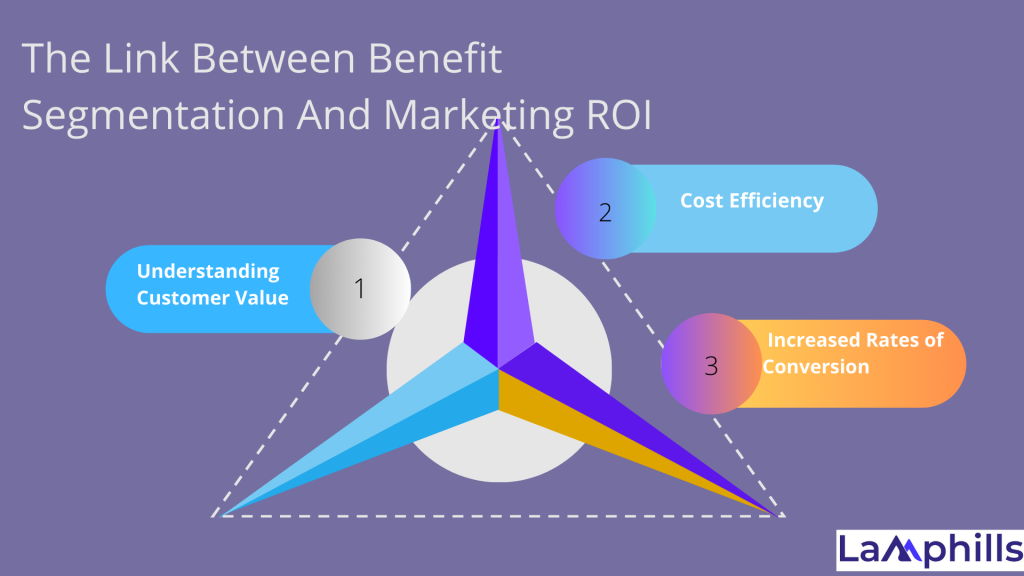
This is where benefit segmentation shines: it can have a significant impact on your return on investment (ROI). It all comes down to making the best use of your marketing spend.
#1: Understanding Customer Value
Rather than casting a wide net, benefit segmentation allows you to focus on the customer categories that add the most value to your business.
#2. Cost Efficiency
Benefit segmentation helps cut down on unnecessary marketing expenditures. You won’t waste money on those who won’t find your message relevant if you focus only on the appropriate target. When you are performing sponsored advertising efforts, this is quite crucial. Targeting a well-defined segment based on their desired benefits will generate higher conversion rates than a general message. The objective is to spend less and get more in return!
#3. Increased Rates of Conversion
Customers are more willing to interact with brands that understand them, I’ve discovered. A message that speaks directly to their desires will compel them to take action, be it subscribing to your newsletter, clicking on a product link, or completing a purchase.
How To Get Started With Benefits Segmentation
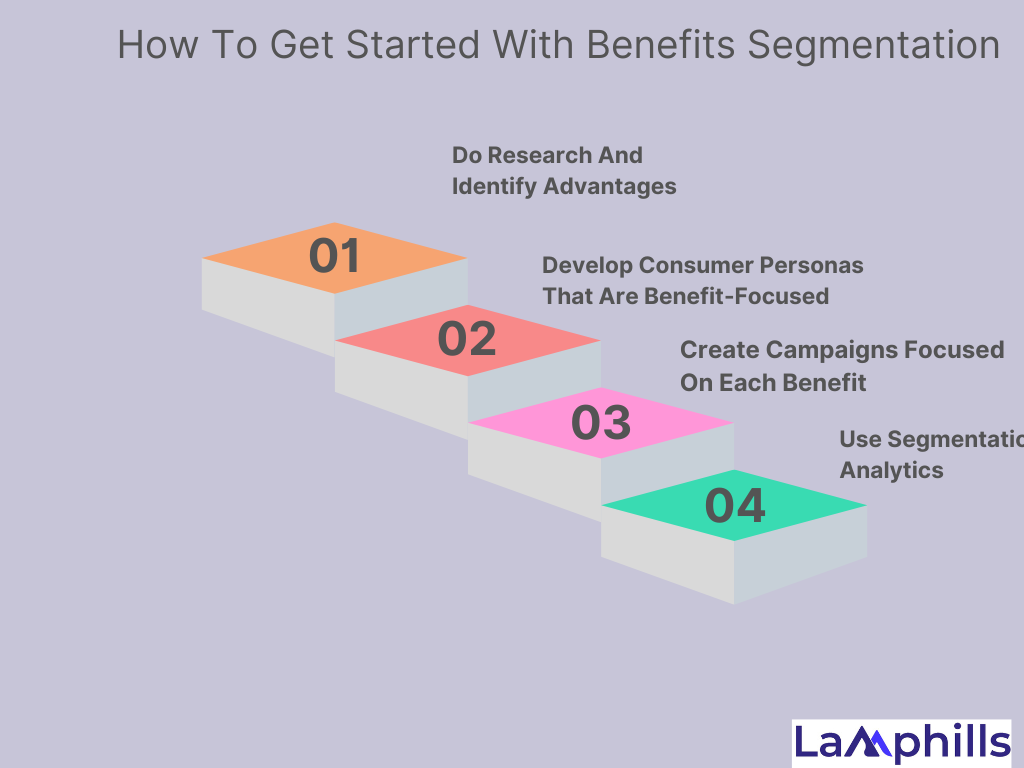
Here’s how to use benefit segmentation to enhance your customized efforts.
#1. Do Research And Identify Advantages
Knowing all the advantages your clients receive from your products is the first step toward implementing benefit segmentation. Don’t discount the value of consumer research, even though you may be aware of some of its advantages. To find out what customers adore about your products, conduct focus groups, ask questions of your target market, and examine customer evaluations.
#2. Develop Consumer Personas That Are Benefit-Focused
It’s time to develop client profiles that accurately represent the advantages that you now recognize. Customers who enjoy comparable benefits should be grouped to see if they share any additional characteristics. Price-conscious consumers may be younger. Maybe people who care about performance have a certain type of job. The more you can do to flesh out what the average benefits-focused consumer looks like, the easier it will be to create campaigns.
#3. Create Campaigns Focused On Each Benefit
We are now at the enjoyable phase. Make the benefit-focused consumer personas you developed in the previous stage the main target of your next marketing initiatives. Avoid attempting to win over everyone. Just make sure they are drawn to your campaigns.
#4. Use Segmentation Analytics
The segmentation analytics tracking sheet below is a game-changing tool for marketers who want to maximize the efficiency and impact of their benefit segmentation strategies.
The quality of your data directly affects how well your benefit segmentation strategy works. That’s why it’s critical to use segmentation analytics with a reliable web analytics tool like Matomo to monitor how each section performs online.
How to Implement Benefit Segmentation For Smarter Campaigns
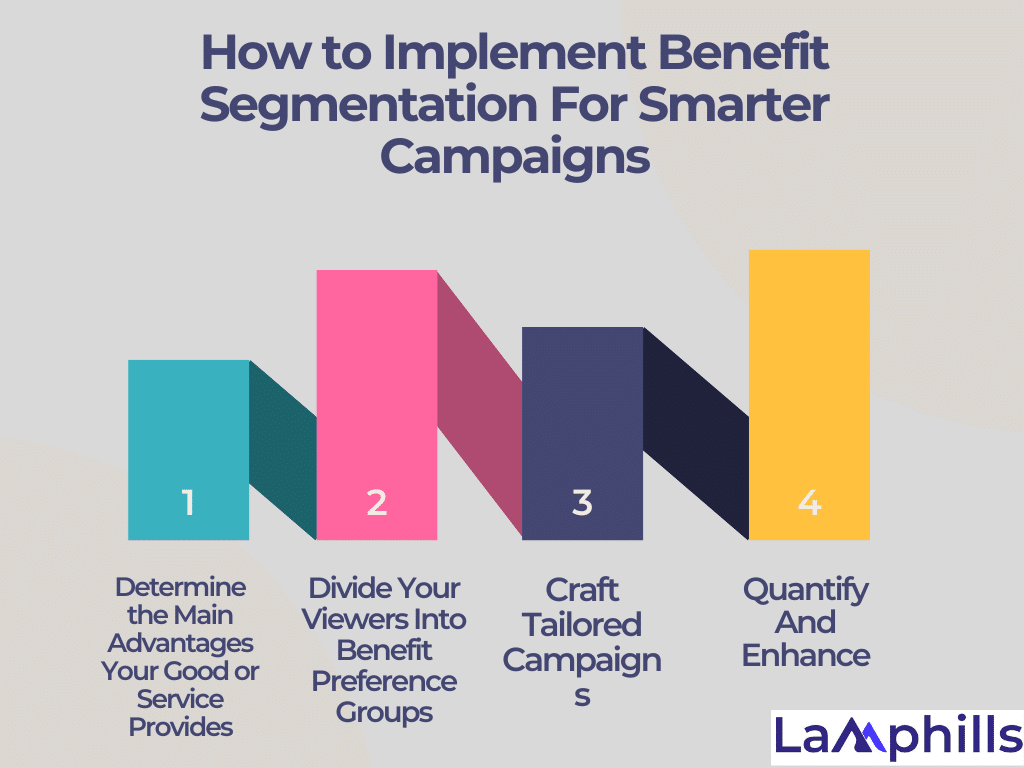
Most likely, you’re asking how benefit segmentation fits into your marketing plan. Here’s a detailed how-to:
#1: Determine the Main Advantages Your Good or Service Provides
Recognizing the primary advantages that your product or service offers is the first step. It is advisable to obtain direct input from your clientele via focus groups, questionnaires, or even customer service inquiries. This will assist you in determining which features of your product are most beneficial to certain clientele segments.
#2: Divide Your Viewers Into Benefit Preference Groups
As soon as you can see which perks are important to your clients, begin grouping them according to these choices. This can be done through data analytics or customer behavior insights. For example, if you observe that certain of your clients consistently buy products related to anti-aging, they’re a clear segment.
#3: Craft Tailored Campaigns
The exciting part is about to begin: creating campaigns! Make communications that emphasize the features that matter most to each group. Herein lies the opportunity for customized messaging. Whatever channels, tone, and style work best for each group should be used. Use language that highlights sales, discounts, and costs, for instance, if you’re trying to attract customers who are budget-conscious.
#4: Quantify And Enhance
Persistent optimization is one of the secrets of marketing success. Be sure to monitor the performance of every segmented campaign. Regarding conversions and engagement, are you getting the expected results? Should this not be the case, modify your offerings, messaging, or even the segments. The process is one of learning!
Why Should You Do Benefit Segmentation?
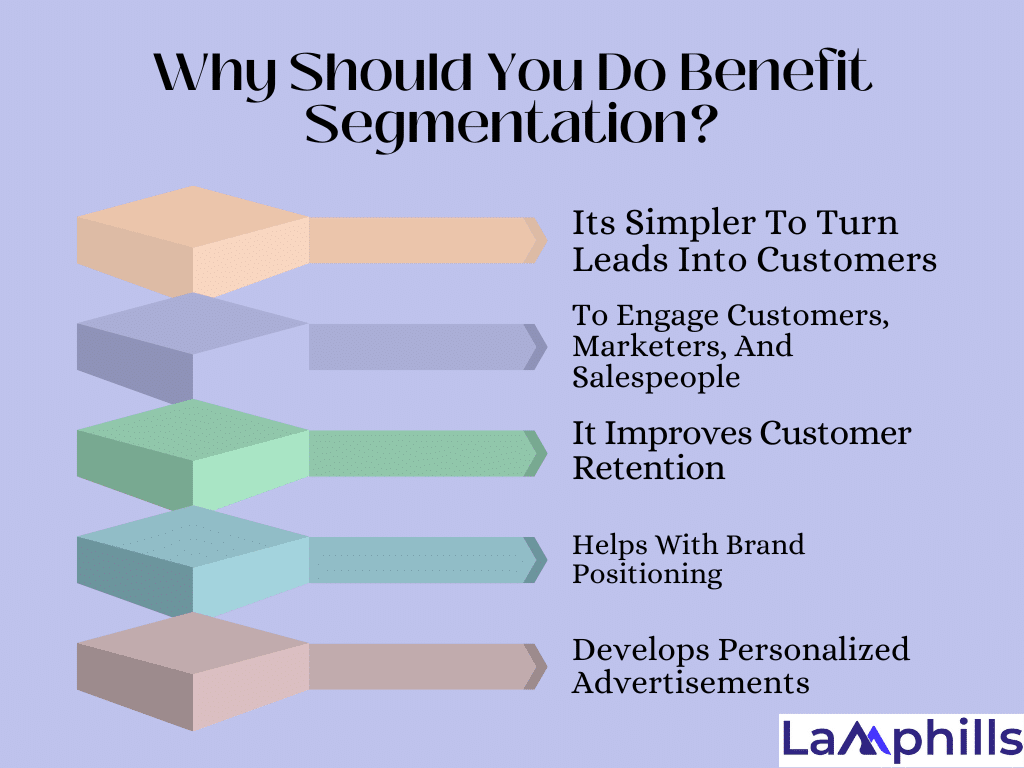
Benefit segmentation will assist you in comprehending the various wants of your clientele as well as the following:
#1. Its Simpler To Turn Leads Into Customers
This is so that your marketing initiatives can draw in clients who are more appropriate for your offering. Your sales team should close more agreements as a result of the campaigns’ focus on the individuals who most need your services.
#2. To Engage Customers, Marketers, And Salespeople
Your team will produce more persuasive sales pitches and marketing efforts by determining the core value that your company offers. They will be adept at making your offering stand out from the competition so that your target will find it appealing.
#3. It Improves Customer Retention
Over time, your churn rate will go down if you convert leads who are a good fit for your company. When your product or service meets their needs, customers will be satisfied and are less likely to use your rivals.
#4. Helps With Brand Positioning
Marketers can take advantage of this knowledge for brand positioning by using the data advantage that segmentation offers. Following the identification of each client category and its associated benefits, marketers can develop a brand position that is consistent with the data findings. In addition to helping you find gaps between what your product offers and what customers demand, benefit segmentation can also inspire the development of new goods.
#5. Develops Personalized Advertisements
Products have different benefits that may cater to certain age or interest groups. Companies can establish a variety of advertising content that targets a particular audience while demonstrating specific benefits relevant to that customer base. Varying advertisements allow products to reach a wider range of audiences and increase the potential for sales performance.
Examples Of Benefit Segmentation
Many different businesses use benefit segmentation. Here are some benefit segmentation examples to better understand this strategy:
#1. Chevrolet
Automotive company Chevrolet uses benefit segmentation to position its different vehicles, which attract different audiences. In the social media ad examples below, Chevrolet highlights the different features of the Equinox and the Corvette Stingray to speak to the target market of each product.
The Equinox ad highlights the vehicle’s versatility. Meanwhile, the Corvette Stingray ad focuses on the iconic nameplate’s history.
#2. Nike
Nike offers several different target markets with a broad range of products. To create unique marketing strategies that appeal to each client category, it must employ benefit segmentation. Our best illustration from Nike is their tennis sensation Serena Williams in their advertisements.
Nike’s target female audience, especially its younger demographic, is the target audience for this advertising. Nike is aware that wearing Nike gear gives these clients a sense of athletic confidence. This is so that their clothing, which is made by Nike, may be both stylish and performant. As an example of how having more confidence can enhance your athletic abilities, the organization presents Serena Williams, the tennis phenomenon.
Product options for various athletes and lifestyles are provided by sports brands such as Nike. Benefit segmentation lets Nike craft marketing campaigns and sort products for each customer group. On its website, Nike has a product category for its maternity collection dedicated to active and pregnant women. Its products are also categorized according to different sports and lifestyles, so users can shop from the collection that suits their interests.
#3. Ford
Benefit segmentation is a common strategy used by automakers to position their various car models. For instance, we can examine Ford to observe how their Ford Fusion and F-150 models are advertised differently.
Ford Fusion: a four-door car with practicality and style that is deemed “sophisticated” and “cool.” Ford understands that buyers of this vehicle will be drawn to its aesthetic appeal in addition to its features and cost. To complement the eye-popping style of the car, the manufacturer underlines this in their marketing by employing brilliant colors.
Now contrast that picture with the Ford F-150 picture that is below. The F-150 is a work truck made for individuals who require a strong, long-lasting car. Clients who are considering the F-150 would value the truck’s impressive towing capacity and ability to navigate difficult terrain. That’s why the image below shows the truck towing a large piece of equipment with a tagline of “Built Ford Tough.”
#4. Airbnb
Airbnb’s market segmentation is unique because it must account for two distinct target audiences: hosts and guests. Not only must the corporation locate clients to rent the rooms, but it must also attract friendly hosts with inviting living environments. This requires Airbnb to use benefit segmentation to produce ads that appeal to both guests and hosts.
The example above demonstrates how Airbnb employs benefit segmentation to recruit hosts in New York City. New Yorkers are very proud of their city, and they admire companies that share that passion. Airbnb designed these subway ads to educate New Yorkers about the benefits of Airbnb for local businesses and community development.
We can compare that educational message to the inspirational one below. This ad is aimed at potential guests who are planning a future trip but haven’t made concrete travel plans. Airbnb capitalizes on this opportunity by creating a message that embraces uncertainty. Rather than pointing to a specific location, Airbnb makes the destination irrelevant and instead focuses on how the company will help, no matter where you go. This makes Airbnb look more trustworthy to customers who may be nervous about making a major financial decision.
#5. Samsung
The mobile phone has become one of the most basic pieces of modern technology. Almost everyone uses a phone to complete their daily chores. However, depending on who you are, how old you are, and where you live, your cell phone needs may change significantly from those of the next customer. Most of us require a mobile phone but for different reasons. So, how do phone companies meet their customers’ needs?
Samsung employs benefit segmentation to tailor advertisements to distinct target populations. In the cell phone market, age is a crucial determinant of client requirements. Customers’ expectations of their cell phones shift as they age. It progresses from fun features like cameras and apps to more practical benefits like battery life and security.
We can see this play out in the two advertisements pictured. The first one is aimed at a youthful audience and inspires them to “Do bigger things.” The phone comes with two cameras and lets the user draw on images using the included stylist.
Compare this to the next advertisement, in which Samsung emphasizes the phone’s utility. Its motto, “Designed for Humans,” indicates that the phone is user-friendly and simple to set up. The phone is intended for the best speed, so it never slows down regardless of how many apps are running at the same time. This is especially handy for an audience with a hectic professional schedule and several responsibilities to do.
What are the two approaches to segmentation?
There are, broadly speaking, two approaches to segmentation: a priori (or prescriptive) and post hoc (or exploratory).
What are the 4 P’s of marketing segmentation?
The 4 P’s of marketing are price, promotion, place, and product—the four key factors every marketer should use to guide their campaign strategy.
How are customers segmented?
Customer segmentation is the process by which you divide your customers up based on common characteristics – such as demographics or behaviors.
What are segmentation strategies?
A segmentation strategy is a marketing concept that refers to a company’s plan for identifying each section of its target market.
Conclusion
Benefit segmentation is a game changer for organizations who want to enhance their marketing ROI. Understanding what benefits your clients genuinely appreciate allows you to build better, more targeted, and ultimately more profitable marketing.
If there’s one thing I’ve learned from my marketing experience, it’s that the more you know about your target demographic, the better your results will be. So, take the effort to segment your audience based on their benefit preferences, and watch your ROI skyrocket.




